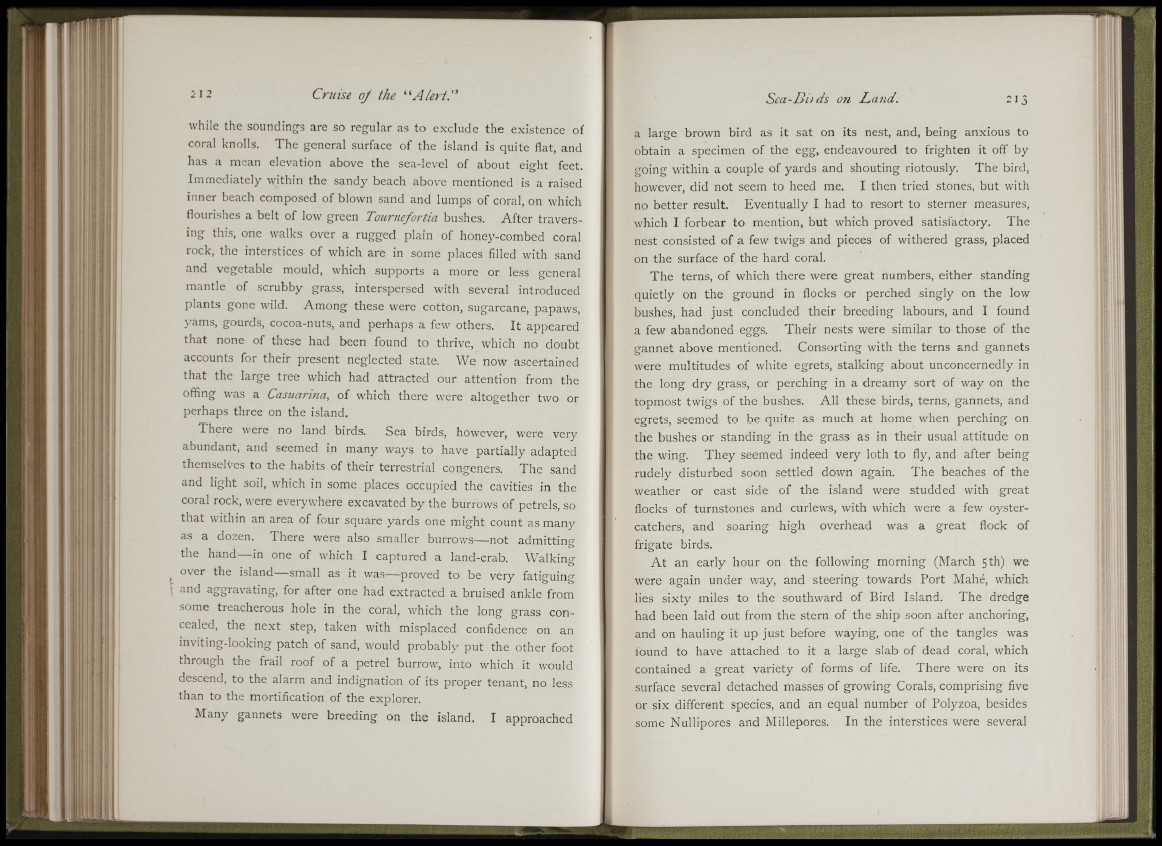
, 1
LH : 1.
l i d
I
while the soundings are so regular as to exclude the existence of
coral knolls. The general surface of the island is quite flat, and
has a mean elevation above the sea-level of about eight feet.
Immediately within the sandy beach above mentioned is a raised
inner beach composed of blown sand and lumps of coral, on which
flourishes a belt of low green Tournefortia bushes. After traversing
this, one walks over a rugged plain of honey-combed coral
rock, the interstices of which are in some places filled with sand
and vegetable mould, which supports a more or less general
mantle of scrubby grass, interspersed with several introduced
plants gone wild. Among these were cotton, sugarcane, papaws,
yams, gourds, cocoa-nuts, and perhaps a few others. It appeared
that none of these had been found to thrive, which no doubt
accounts for their present neglected state. We now ascertained
that the large tree which had attracted our attention from the
offing was a Casuarina, of which there were altogether two or
perhaps three on the island.
There were no land birds. Sea birds, however, were very
abundant, and seemed in many ways to have partially adapted
themselves to the habits of their terrestrial congeners. The sand
and light soil, which in some places occupied the cavities in the
coral rock, were everywhere excavated by the burrows of petrels, so
that within an area of four square yards one might count as many
as a dozen. There were also smaller burrows-
-not admitting
the hand— in one of which I captured a land-crab.
Walkinsr
^ over the island small as it was— proved to be very fatiguing
S and aggrav'ating, for after one had extracted a bruised ankle from
some treacherous hole in the coral, which the long grass concealed,
the next step, taken with misplaced confidence on an
inviting-looking patch of sand, would probably put the other foot
through the frail roof of a petrel burrow, into which it would
descend, to the alarm and indignation of its proper tenant, no less
than to the mortification of the explorer.
Many gannets were breeding on the island. I approached
a large brown bird as it sat on its nest, and, being anxious to
obtain a specimen of the egg, endeavoured to frighten it off by
going within a couple of yards and shouting riotously. The bird,
however, did not seem to heed me. I then tried stones, but with
no better result. Eventually I had to resort to sterner measures,
which I forbear to mention, but which proved satisfactory. The
nest consisted of a few twigs and pieces of withered grass, placed
on the surface of the hard coral.
The terns, of which there were great numbers, either standing
quietly on the ground in flocks or perched singly on the low
bushes, had just concluded their breeding labours, and I found
a few abandoned eggs. Their nests were similar to those of the
gannet above mentioned. Consorting with the terns and gannets
were multitudes of white egrets, stalking about unconcernedly in
the long dry grass, or perching in a dreamy sort of way on the
topmost twigs of the bushes. All these birds, terns, gannets, and
egrets, seemed to be quite as much at home when perching on
the bushes or standing in the grass as in their usual attitude on
the wing. They seemed indeed very loth to fly, and after being
rudely disturbed soon settled down again. The beaches of the
weather or east side of the island were studded with great
flocks of turnstones and curlews, with which were a few oyster-
catchers, and soaring high overhead was a great flock of
frigate birds.
A t an early hour on the following morning (March 5th) we
were again under way, and steering towards Port Mahe, which
lies sixty miles to the southward of Bird Island. The dredge
had been laid out from the stern of the ship soon after anchoring,
and on hauling it up just before waying, one of the tangles was
found to have attached to it a large slab of dead coral, which
contained a great variety of forms of life. There were on its
surface several detached masses of growing Corals, comprising five
or six different species, and an equal number of Polyzoa, besides
some Nullipores and Millepores. In the interstices were several
.4